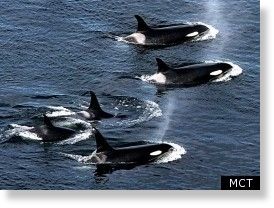
© McClatchy-Tribune News ServiceOffshore orcas
Scientists have documented a coordinated, gruesome attack on a school of sleeper sharks by a little-studied group of orcas that ranges from California to Alaska's Aleutian Islands. An article published recently in the journal Aquatic Biology tells of a 2008 feeding frenzy in British Columbia waters just south of the Alaska border,
reports the Canadian Press.
The [orcas] were hyperventilating, arching their backs and diving deep.
On the hydrophone, [Canadian scientist John] Ford could hear their excited songs.
Minutes passed and then a chunk of tissue -- about 250 grams in size and later proven to be part of a liver -- floated to the surface, coming to rest in a slick of oil.
More and more tissue and oil soon appeared, covering an area of ocean in a sheen hundreds of metres in size and flattening the water's ripples.
Ford believes the killer whales target sharks because the nutritional payoff is good.
Ford thinks orcas are targeting sharks because their livers are rich in fatty oils and energy.
"We believe that for killer whales generally that they are going after the most profitable prey, which tend to be the bigger kinds of body sizes and the highest oil content," he said.
In general, non-migratory orcas ("residents") feed on salmon and other fish, while near-shore "transients" feed on marine mammals. But the diet of these
offshore whales, which cruise the outer continental shelf in groups of 30 to 70, has remained a mystery. Ford also tells of an attack on sharks by orcas in Prince William Sound in 2009.




Reader Comments
the killer whales will rise up-kill us all-nah
think of all the stupid zombie flicks. How slow does one have to be to get caught by a Killer whale on land?
RC